|
The Blakely Burl Tree Project:
From The Ground Up
by Terry Martin |
THE TEAM ASSEMBLES IN BLAKELY
Soon we arrive at Blakely, the county seat of Early County and the
focus of the project that has bought us from far and away. The town has about
5500 citizens, but my impression is of a much smaller town as we drive through
sparse housing. Soon we pull into the central square, which Powell had
described:
| The courthouse square, or the Square, as it was commonly called, consisted
of four acres, which means that there was about four hundred feet of frontage on
each side of it. The courthouse stood in the center, and along the sides of the
Square were stores, offices, hotels, livery stables, and dwellings. |
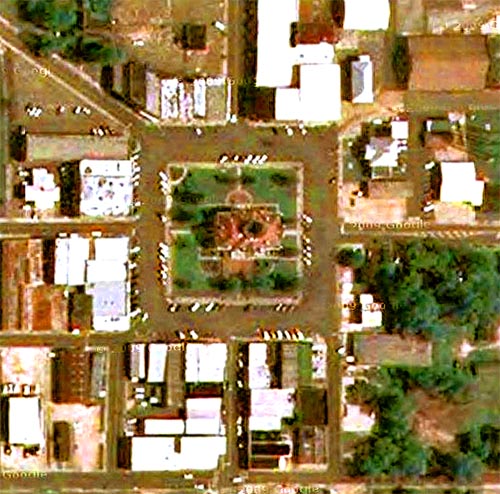
Satellite photo of
Blakely Courthouse Square
(Google maps)
My first impression is that not much has
changed. The grand courthouse, built in 1904, has been beautifully restored and
could grace a much larger city. However, as we drive around the Square it soon
becomes clear that the community Powell described has taken some hard knocks
over recent years. Some businesses seem to be doing well, but there are empty
store windows and down the side streets I glimpse derelict buildings. It is a
first hint of why Charles Rice was so sad about the decline of his hometown.

Early County Courthouse, 2009
Photo: John McFadden
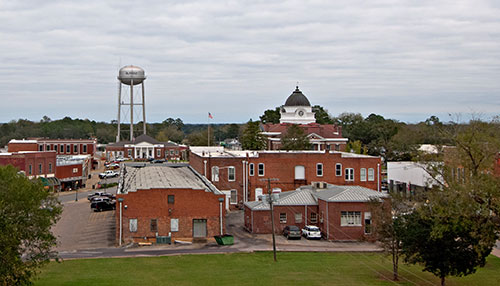
Courthouse from elevated view at
Blakely Burl Tree site
Photo:
Mark Lindquist
We peel off from the town square and a short block away find a vacant lot where
a tall, distinguished man stands beside a car waiting for us. ďGood morning, Iím
Jim Murkeson," he says, ďand Iím the Sheriff around here. Iíve come down to make
sure everything is OK.Ē Itís a good start. Later I learn that Jim has been
Sheriff for 25 years. He is a man deeply committed to his community and a
thoroughgoing gentleman.
Soon we are joined by Stanley Houston, Charlesí lifetime friend and
self-proclaimed ďbird dogĒ for the Early County project. Even though he has his
own business, it soon becomes apparent that Stanley is the man to ask if you
want anything done. Heís always there when you need him and his never-failing
courtesy is confirmation for me that what Iíve heard about southern folk is
true. They really do believe in good manners.
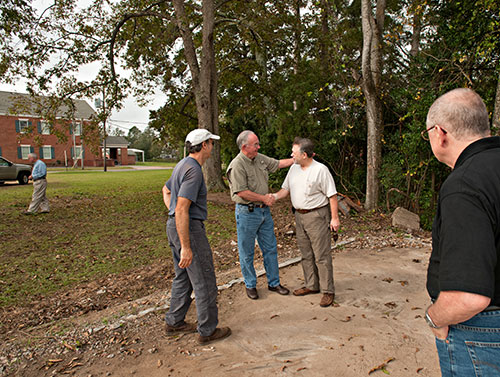
(From Left to right) Sherrif
Murkeson, Chris Smith, Stanley Houston,
Mark Lindquist, Terry Martin
Photo: John McFadden
Others start arriving and in no time the large slab of concrete where the J. B.
Rice Plumbing & Electrical Co. used to be is filled with people introducing
themselves, all taking advantage of a lull in the rain. Mark is making sure
everybody meets everybody and he introduces us to Chris Smith, another key
member of the harvest team. He is a fine furniture maker from Florida, a quiet,
unassuming man, but he will prove to be a tireless worker and he brings a
lifetime of expertise to the project. Local contractor Jim Carver is also there
with his team of workers. People are really eager to start work and the energy
level is high.
I notice one man quietly standing back and Mark takes me across to meet him.
ďIím Steve Cross,Ē he says with a broad smile, ďNice to meet you.Ē We shake
hands and Iíve been introduced to one of the most colorful characters Iíve ever
met in my life. I believe it's impossible to render Steve Cross's speech in
writing, but when he says, "Nice to meet you," it takes three times as long as
the average speaker to finish the sentence. Each vowel rolls along, up and down,
exploring every possible nuance of tone and color. I find it soothing music.
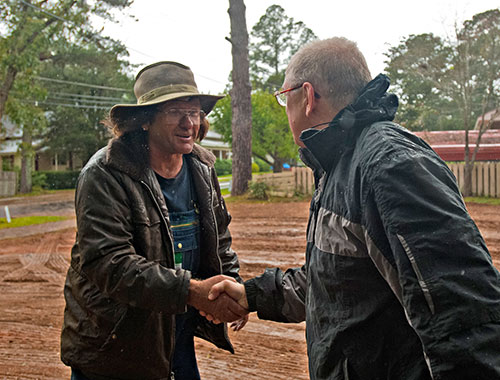
Steve Cross (left), meeting Terry Martin
Photo: John McFadden
While everyone completes the introductions my eye is drawn to the tree standing
in the background. I recognize it from photographs and wander over for a closer
look. It slightly leans across the Big Ditch and is flattish on one side where
it had flanked the building that used to be there. When I lean over the edge of
the Ditch I can see that there is a lot more of the tree out of easy view. Soon
we will discover that there is a lot of wood down there.
The film crew, Director Ken Brown and cinematographer Greg Andracke, arrive in
their rental van after flying into Atlanta from New York. Some of us know Ken
already from an exhibition project the previous year in Chicago. He is an Emmy
award winning producer/director with a string of impressive credits. It is the
first time we have met Greg. We are all curious to meet this tough-looking man
who has a reputation for filming in hotspots around the world for major
television productions. In fact he is fresh from Afghanistan, something that
will provide us with many interesting mealtime stories. Greg is an Oscar-winning
documentary maker and we soon learn that many films we know well were shot by
him.
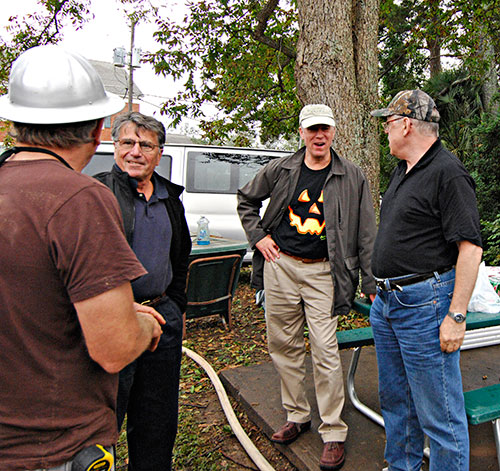
(left to right) Gary Stevens, Greg
Andracke, Ken Browne, Terry Martin
meeting for first time in Blakely on site of BBTP
Photo:
Mark Lindquist
Mark already prepared a plan for the site and he is pleased to see that,
courtesy of Stanley and his local team, power, water and waste disposal have
been laid on. Also, the Big Ditch has been dammed to keep the base of the tree
free of water. Across the road there is a large old metal Quonset hut where the heavy
equipment has been stored. Once we are sure where everything is, Gary maneuvers
the motor home onto the site and as the rain returns, we all take a collective
breath. The work begins.
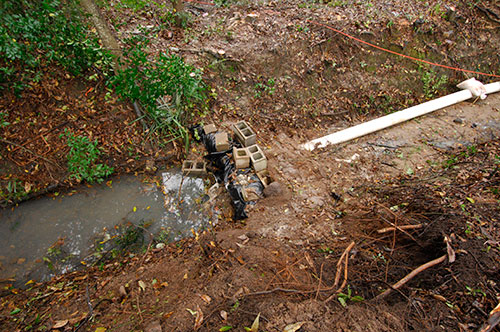
Temporary by-pass dam in "Big Ditch"
Photo:
Mark Lindquist
|